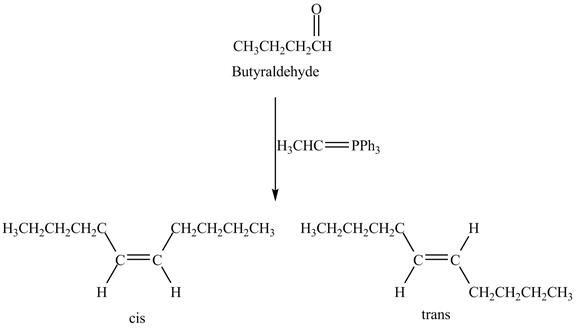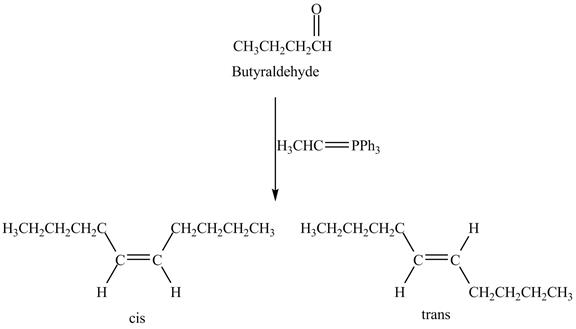
Concept explainers
(a)
Interpretation:
The product formed in the reaction of butyraldehyde and
Concept introduction:
Grignard reagents are
Answer to Problem 19.41AP
The product formed in the reaction of butyraldehyde and

Explanation of Solution
Butyraldehyde reacts with
The reduction of butyraldehyde takes place to form the product. The reaction is shown below.

Figure 1
The product formed in the reaction of butyraldehyde and
(b)
Interpretation:
The product formed in the reaction of butyraldehyde and
Concept introduction:
The gain of electrons involved in the particular reaction is termed as reduction. The reduction process also involves the removal of an electronegative atom from a molecule followed by the hydrogen atom addition into that molecule.
Answer to Problem 19.41AP
The product formed in the reaction of butyraldehyde and

Explanation of Solution
Butyraldehyde reacts with
The reduction of butyraldehyde takes place to form the product. The reaction is shown below.

Figure 2
The product formed in the reaction of butyraldehyde and
(c)
Interpretation:
The product formed in the reaction of butyraldehyde and alkaline
Concept introduction:
Oxidation is the process of addition of oxygen. Oxidation is also defined as loss of electrons. In the oxidation process, there is increase in the oxidation state. The acid is added in the reaction for protonation.
The oxidizing agent is defined as the species which oxidizes others and itself gets reduced.
Answer to Problem 19.41AP
The product formed in the reaction of butyraldehyde and

Explanation of Solution
Butyraldehyde reacts with

Figure 3
The product formed in the reaction of butyraldehyde and alkaline
(d)
Interpretation:
The product formed in the reaction of butyraldehyde and aqueous
Concept introduction:
Oxidation is the process of addition of oxygen. Oxidation is also defined as loss of electrons. In the oxidation process, there is increase in the oxidation state. The acid is added in the reaction for protonation.
The oxidizing agent is defined as the species which oxidizes others and itself gets reduced.
Answer to Problem 19.41AP
The product formed in the reaction of butyraldehyde and aqueous

Explanation of Solution
Butyraldehyde reacts with aqueous

Figure 4
The product formed in the reaction of butyraldehyde and aqueous
(e)
Interpretation:
The product formed in the reaction of butyraldehyde and
Concept introduction:
Oxime belongs to the family of imines. The formula of oxime is
Answer to Problem 19.41AP
The product formed in the reaction of butyraldehyde and

Explanation of Solution
Butyraldehyde reacts with ![]() . When the
. When the ![]() is high then the product formed is an
is high then the product formed is an ![]() is low then the product is not formed. The reaction is shown below.
is low then the product is not formed. The reaction is shown below.

Figure 5
The product formed in the reaction of butyraldehyde and
(f)
Interpretation:
The product formed in the reaction of butyraldehyde and
Concept introduction:
Oxidation is the process of addition of oxygen. Oxidation is also defined as loss of electrons. In the oxidation process, there is increase in the oxidation state. The acid is added in the reaction for protonation.
The oxidizing agent is defined as the species which oxidizes others and itself gets reduced.
Answer to Problem 19.41AP
The product formed in the reaction of butyraldehyde and

Explanation of Solution
Butyraldehyde reacts with

Figure 6
The product formed in the reaction of butyraldehyde and
(g)
Interpretation:
The product formed in the reaction of butyraldehyde and zinc amalgam in the presence of
Concept introduction:
Clemmensen reduction is defined as the reduction in which aldehydes or
Answer to Problem 19.41AP
The product formed in the reaction of butyraldehyde and zinc amalgam in the presence of

Explanation of Solution
Butyraldehyde reacts with zinc amalgam in the presence of

Figure 7
The product formed in the reaction of butyraldehyde and zinc amalgam in the presence of
(h)
Interpretation:
The product formed in the reaction of butyraldehyde and
Concept introduction:
The Wittig reaction is the
Answer to Problem 19.41AP
The geometrical isomers are formed in the reaction of butyraldehyde and

Explanation of Solution
Butyraldehyde reacts with

Figure 8
Butyraldehyde reacts with
Want to see more full solutions like this?
Chapter 19 Solutions
EBK ORGANIC CHEMISTRY
- 21.38 Arrange the molecules in each set in order of increasing acidity (from least acidic to most acidic). OH OH SH NH2 8 NH3 OH (b) OH OH OH (c) & & & CH3 NO2 21.39 Explain the trends in the acidity of phenol and the monofluoro derivatives of phenol. OH OH OH OH PK 10.0 PK 8.81 PK 9.28 PK 9.81arrow_forwardidentify which spectrum is for acetaminophen and which is for phenacetinarrow_forwardThe Concept of Aromaticity 21.15 State the number of 2p orbital electrons in each molecule or ion. (a) (b) (e) (f) (c) (d) (h) (i) DA (k) 21.16 Which of the molecules and ions given in Problem 21.15 are aromatic according to the Hückel criteria? Which, if planar, would be antiaromatic? 21.17 Which of the following structures are considered aromatic according to the Hückel criteria? ---0-0 (a) (b) (c) (d) (e) (h) H -H .8.0- 21.18 Which of the molecules and ions from Problem 21.17 have electrons donated by a heteroatom?arrow_forward
- 1. Show the steps necessary to make 2-methyl-4-nonene using a Wittig reaction. Start with triphenylphosphine and an alkyl halide. After that you may use any other organic or inorganic reagents. 2. Write in the product of this reaction: CH3 CH₂ (C6H5)₂CuLi H₂O+arrow_forward3. Name this compound properly, including stereochemistry. H₂C H3C CH3 OH 4. Show the step(s) necessary to transform the compound on the left into the acid on the right. Bri CH2 5. Write in the product of this LiAlH4 Br H₂C OHarrow_forwardWhat are the major products of the following reaction? Please provide a detailed explanation and a drawing to show how the reaction proceeds.arrow_forward
- What are the major products of the following enolate alkylation reaction? Please include a detailed explanation as well as a drawing as to how the reaction proceeds.arrow_forwardA block of zinc has an initial temperature of 94.2 degrees celcius and is immererd in 105 g of water at 21.90 degrees celcius. At thermal equilibrium, the final temperature is 25.20 degrees celcius. What is the mass of the zinc block? Cs(Zn) = 0.390 J/gxdegrees celcius Cs(H2O) = 4.18 J/gx degrees celcusarrow_forwardPotential Energy (kJ) 1. Consider these three reactions as the elementary steps in the mechanism for a chemical reaction. AH = -950 kJ AH = 575 kJ (i) Cl₂ (g) + Pt (s) 2C1 (g) + Pt (s) Ea = 1550 kJ (ii) Cl (g)+ CO (g) + Pt (s) → CICO (g) + Pt (s) (iii) Cl (g) + CICO (g) → Cl₂CO (g) Ea = 2240 kJ Ea = 2350 kJ AH = -825 kJ 2600 2400 2200 2000 1800 1600 1400 1200 1000 a. Draw the potential energy diagram for the reaction. Label the data points for clarity. The potential energy of the reactants is 600 kJ 800 600 400 200 0 -200- -400 -600- -800- Reaction Progressarrow_forward
- Can u help me figure out the reaction mechanisms for these, idk where to even startarrow_forwardHi, I need your help with the drawing, please. I have attached the question along with my lab instructions. Please use the reaction from the lab only, as we are not allowed to use outside sources. Thank you!arrow_forwardHi, I need your help i dont know which one to draw please. I’ve attached the question along with my lab instructions. Please use the reaction from the lab only, as we are not allowed to use outside sources. Thank you!arrow_forward
 Chemistry: Principles and ReactionsChemistryISBN:9781305079373Author:William L. Masterton, Cecile N. HurleyPublisher:Cengage Learning
Chemistry: Principles and ReactionsChemistryISBN:9781305079373Author:William L. Masterton, Cecile N. HurleyPublisher:Cengage Learning
